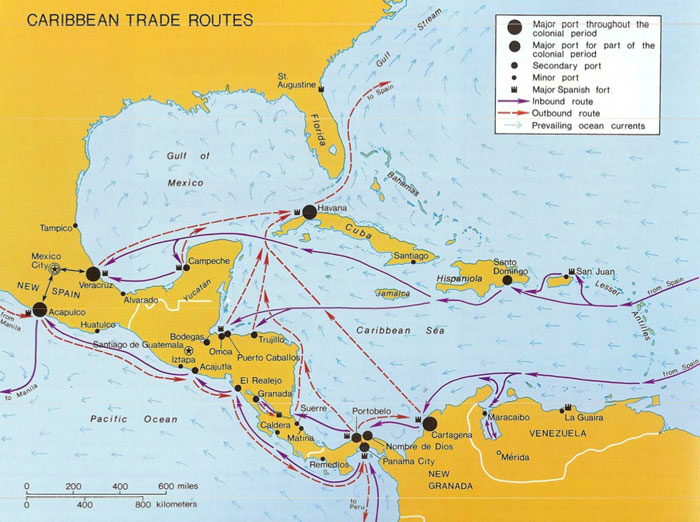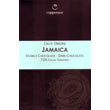FLAVOR PROFILE: light fruit, cane rum, & all-spice contrast wood, carob, & coffee; medium body, finely acidic / tannic.
CHARACTERISTICS: supple mix of perhaps early Mesoamerican cacáo; some Venzys of the so-called ‘Caracas’ variety; plus an Amazonian type via Hispaniola.
Cacáo to the People
Mounting archeological evidence depicting cacáo on iconography (notably the cacáo tree was a symbol of royal lineage at Palenque Mexico, augmented by research of Cameron McNeil at Copán), as well as sumptuary laws & eyewitness accounts by historian Gonzalo Fernández de Oviedo suggest that cacáo was not entirely exclusive but mainly the reserve of caciques (rulers) & the wealthy elite among Mesoamerican societies, who usually owned the land on which it grew, controlling its production & distribution. And since it also circulated as currency, to consume it would literally be a waste of money to the poor who could ill-afford to do so, though some, perhaps many, did anyway.
Likewise in Europe, chocolate remained in the realm of the privileged aristocracy, particularly in France under the Sun King Louis XIV & in Spain throughout the Bourbon reign. They awarded royal warrants or contracts to private individuals & syndicates who bid to obtain what amounted to monopolies. This type of internal “out-sourcing” allowed the Court to reap benefits without bearing administrative costs. In exchange for a fixed annuity paid into the royal treasury (traditionally on a bi-annual basis at Christmas & in June), the Crown granted exclusive rights to process, sell, & distribute a luxury item within a bordered geographic area for a specified period of time. Purveyors securing warrants were typically well-known, wealthy property-holders of some standing at the Royal Court who could afford to tender the “signing bonus”. They belonged to the club, connected in some way or another to the labyrinthine network of nobles, priests & soldiers.
Royal chocolate held… that is, until the men-o’-war of the British Navy wrested Jamaica away from Spanish galleons in 1655, just a midpoint really in a storied history that would write scripts for untold books & movies to come.
After being repelled by the Spanish at Santo Domingo in Hispaniola during the ‘Western Design’ campaign of the Anglo-Spanish War a year earlier, English seaman fearing the wrath of Cromwell captured Jamaica as a consolation prize. Recognizing the difficulty in holding their new catch, The Brethren of the Coast (a loose-knit band of pirates) found safe harbor in Port Royal, Jamaica – giving it a Sodom-of-the-New World makeover – having been invited in by the Crown to help defend it! Strategically located right in the hub of shipping lanes / trade routes where Spain built the world’s largest navy & the most extensive chain of fortresses to protect her bounty (much of it underwritten by an avería or fleet tax), pirates used Jamaica for a staging area, lurking the waters… plying Spanish cargo ships directly in the cross-hairs between her strongholds on the continental mainland & weaker islands in the Eastern Caribbean where Spanish presence was fading.
The getting was tremendous: extremely large loot full of rich treasure – gold melted down from Aztec & Incan masks, jewelry & art; silver tapped from Potosí by forced labor; pearls from nearby waters; sugar ‘n spices harvested by slaves. The take from piracy alone would quickly surpass the rest of the island’s GDP.
A colorful slew of characters, the same desires that drove their targets – Hernan Cortés’ & the Spanish – motivated them as well, except they fought for sheer profit rather than any mere appearance of patriotism. Additionally, some pirated to escape drudgery, such as Stede Bonnet, a wealthy gentleman-farmer bored of his wife on their sugar plantation in Barbados.
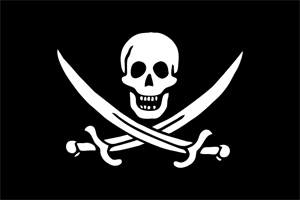 This battling bunch teeming with castoffs, runaways, ex-cons, vagabonds & troublemakers turned into trouble for foes that dared to cross them. Their rebellious spirit meant a willingness to buck the establishment, & always on their own terms.
This battling bunch teeming with castoffs, runaways, ex-cons, vagabonds & troublemakers turned into trouble for foes that dared to cross them. Their rebellious spirit meant a willingness to buck the establishment, & always on their own terms.
They seized ships, raped women, & burned down whole towns – a highly profitable business model operating under the principle ‘no prey / no pay’. Anyone worth two cents soon came to see the advantages of this lifestyle glamorized by Calico Jack who re-designed the black flag sporting the skull & crossbones harmlessly known as the Jolly Roger, outfitting it with swords, & captained Anne Bonny & Mary Read – 2 babes in the annals of piracy who positively rocked the boat.
Or as the most successful raider in the Golden Age of Piracy (roughly from 1650 to when his death marked its end in 1722) ‘Black Bart’ Roberts said: ‘tis better being a commander than a commoner. And he was most uncommon indeed, angered by the cowardice of any opposing captains who abandoned their ships upon seeing his!
Such bravado was part of a shrewd economic policy. Pirates earned their frightening reputations largely thru their own PR while doing their utmost to avoid actual conflict. Roberts himself intimidated more than violated. After all, he supposedly drank tea instead of rum, ironic considering how he met his end, in no small way because his crew was drunk. Killed by vanity… before the final grapeshot fired from the HMS Swallow lodged in his throat terminating his life (impossible to make this up), he ran down below the deck to get dressed in splendid regalia thinking such bluster would work one more time.
That they constituted a bottom-up, very democratically organized fraternity, too successful to live the piratical myths of lawlessness, shows just the opposite: pirates bought into ‘law ‘n order’, along with honesty sworn unto themselves upon a hatchet for want of a Bible. Each typically received an equal share for equal work in the partnership. (Unlike modern-day gang pirates patrolling off the coast of Somalia in the Indian Ocean & the Sea of Aden who exhibit rampant inequality.) And how could it be any other way if “free riders” once taken onboard would lead to resentment & retaliation? Invisible Hand capitalist, Adam Smith: “If there is any society among robbers & murderers, they must at least… abstain from robbing & murdering each other.”
Like the majority of businessmen everywhere, pirates sought stability, which meant no gratuitous violence. They hoped their reputation preceded them to the point that it alone would disarm any resistance. Usually it did. Just the sight of a black flag sporting skull & crossbones (harmlessly known as the Jolly Roger) often proved enough. Of course, sometimes they were forced to go violent, & that too was good for business in a win-win proposition since reports would then leak to newspapers, helping to spread the word from port to port. Occasionally pirates went so far to plant false stories themselves in grisly & gory detail because, to cite economist Peter Leeson’s book The Invisible Hook, perpetuating the myth minimized losses & maximized profits. That journalism eventually got exaggerated gave rise to the pirate’s Disney caricature of today.
As much honor as there was among these thieves, they had their faults… less swashbuckling heroes than floating bandits. But in their own eyes they were just opportunistic, hijacking from what today would be categorized ‘rogue states’, reasoning if the State could legally engage in organized racketeering, why not individual citizens? This lies at the heart of every perverse romance over outlaws from Jesse James to Bonnie & Clyde.
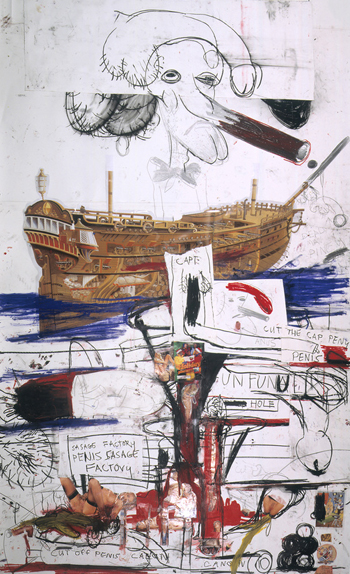 Paul McCarthy’s critical tribute to pirates (2001)
Paul McCarthy’s critical tribute to pirates (2001)
Spain would ever more be dogged at sea for decades by pirates flying the Black Flag as well as privateers sailing under the Union Jack, the latter granted a Letter of Marque (a commission) by the State to raid enemy ships (naturally the government received a cut of the action) who often moonlighted as pirates… & vice-versa, making them indistinguishable at times & making for complicating alliances. Legendary confusion abounded –
John Hawkins, chief architect of the modern Royal Navy that would rule the high seas & defend a vast empire, was a privateer & slave merchant to boot who wrote about the details of his 3rd voyage (1567-69) in An Alliance to Raid for Slaves;
Sir Francis Drake, the ‘Sir’ from being knighted in no small part for commandeering the Cacafuego (Spanish for ‘shit-fire’), the most successful pirate raid in history that made Elizabeth I back in England a fabulously wealthy queen. She lived off the cache for the balance of her reign, never disclosing the full fortune from its hulls for fear of reprisals from the Spanish;
One of the most notorious buccaneers, Capt. Sir Henry Morgan, later of modern rum fame, burned Panama City (Casco Antiguo) in 1670, then Porto Bello in 1688, both deep within the heart of the Spanish Main (the coastline of its mainland Empire), delivering big blows. Among the few pirates to die in bed, rich & respected, he became Port Royal’s lieutenant governor.
All together, the treasure-hunting voyages of the pirates contributed to taking down the Spanish empire & brought armed trading to the high seas. In defense, the Spanish Fleet adjusted to the challenge & changed tactics that proved extremely effective from downsizing its craft, to expanding convoys, & shifting ports. It managed, after all, to extract & export fabulous resources in what some describe ‘the rape of the Americas’. In sum, Mother Nature (hurricanes, storms, etc.) as much as any other force, may have been more harmful than piracy to its New World enterprise.
Once claimed, Jamaica immediately became England’s main supplier of cacáo &, in true pirate spirit, heralded the democratization of chocolate that would eventually conquer the masses because the Brits, with their burgeoning coffee-shops open to everyone, made the potent cocoa-brew available to all who could afford it, starting with a chocolate house on Gracechurch Street in 1657. Soon, refined chocolate-houses & coffee-shops sprouted all over London, offering drinks, smoke, & highly dangerous conversation (political & intellectual topics grew seriously heated & Charles II attempted to shutter them as hotbeds of sedition). A luxury Starbucks, of sorts, these salons doubled as stocks markets, mercantile exchanges, & insurance companies. They also harkened back to the basement of the great teocali (Nahua for ‘temple’) called the ‘House of Eagles’ in the Mexìcâ (Aztec) capital of Tenochtitlan featuring cacáo, tobacco, plus music & poetry.
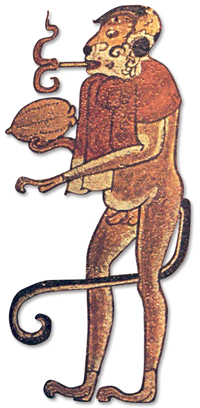
Smokin’ Monkey Man – Drinking vessel (detail); Late Classic Maya (600-750 CE). Monkeys are the great purveyors of cacáo seeds in the jungle & Mesoamericans associated them with creativity & art. This shows the chocolate / tobacco connection (cacáo pod held in his right hand) by the Maya, later extended by the Mexìcâ, plus the excitement of it all (tail between his legs).
Jamaica’s cacáo orchards, called “walks” to fit right in with rasta-chillum island-time, began with plantings from the Atlantic coast of Mesoamerica, so reported by Sir Hans Sloane (founder of the British Museum; surgeon to George II) while stationed on the island in 1707 as the personal physician to the colonial governor.
An intrigue arises over who brought them there & when.
Carried by pirates who became distributors of cacáo throughout the Caribbean?
Inside Baseball: The Case for Pirates
Records are scant, even official ones. It’s not as if pirates usually kept a diary or daily journal. Among the lone exceptions: Alexandre Olivier Exquemelin, a Frenchman best known as the author of one of the most important sourcebooks on piracy. Originally published in Dutch as De Americaensche Zee-Roovers in 1678, cacáo is hardly ever mentioned by him.
Circumstantial evidence, however, implicates pirates in having a hand in saving or at least expanding cacáo’s distribution & diversity, perhaps detrimentally since what they might’ve brought back into Mesoamerica in large measure supplanted the famed cacáo orchards of the area.
While cacáo production on the mainland increased during the 1500s under Spanish rule, it precipitously declined in the 1600s, by more than half. Many cite some unspecified blight, even locusts. More likely, sheer exhaustion led to the drop, caused by the inability of lands to sustain themselves thru continuous farming. Prior to agribiz & petrochemical fertilizers, milpa cultivation on the Yucatán peninsula required long fallow times for land to replenish. Mayans evolved a 30-year rotational cycle, farming each plot 2 or 3 consecutive seasons before soil nutrients were depleted. Cacáo, which bears fruit continuously & lives up to 20 or 30 years, thrived within this tradition. Breaking with it, the Spanish plowed ahead year after year after year until production suffered.
This loosened trade between the Colonies, until then highly restricted by La Casa de Contratación back in Séville, Spain trying to corner the market & enforce the Crown’s monopoly on its New World possessions. Sensing that La Casa’s grip paradoxically loosened its ability to produce cacáo (like squeezing a bird-in-hand too hard that it either flies away or dies), Colonists transported it elsewhere hoping to revive their fortunes, avoid taxation, & slip the controls that La Casa imposed.
Settlers took it to Venezuela. Capuchin monks moved some to nearby Trinidad, right off Venezuela’s coast. Those, however, both lie along or within striking distance to the Spanish Main, affording growers at least a perceived measure of protection from European rivals & pirates.
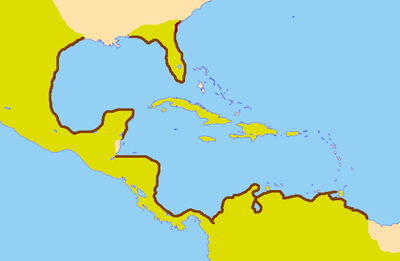 (above) The Spanish Main — outlined in brown; (below) principle trade routes… note Jamaica’s central location within the network (from Historical Atlas of Central America by Carolyn Hall & Hector Perwz Brignoli)
(above) The Spanish Main — outlined in brown; (below) principle trade routes… note Jamaica’s central location within the network (from Historical Atlas of Central America by Carolyn Hall & Hector Perwz Brignoli)
Would Spaniards dare plant such a valuable cash crop far from secured forts, on vulnerable islands, & potentially hand its enemies a bounty?
Jamaica… maybe, because they felt that island sat close enough to their Cuban, & less so Hispaniola, strongholds.
Some background chronology:
1590-1610 – Historian Marcy Norton claims demand for chocolate skyrockets in Spain
1618 – Beginning of the 30-Years War back in Europe forces Spain to divert resources & significantly weakens her defenses in the New World
1620s – Pirates of the Caribbean on the rise
1625 – France captures Martinique from the Spanish
1628 – privateer Piet Hein captures a truly stunning cache of the Spanish “silver fleet”. In September of that year, he sailed out to intercept 16 treasure ships laden with gold, silver, cocoa, plus other luxuries. The total take was 11,509,524 guilders – a phenomenal sum at the time. It came without any cost of bloodshed either, a remarkable bonus owed to Hein himself who differed from common pirates by enforcing a stricter honor code that penalized misconduct among his crews & held for the day rather enlightened views about Amerinds, Africans & people of other religions.
1630s – The Spanish maintain only a laughably small garrison on Trinidad where the island sieves with corruption. The local governor there serves an all-too-happy recipient of bribery, making for a wide-open port accessible to everyone. Particularly Dutch smugglers sailing out of the large natural harbor at Willemstad, Curaçao — the base for the Dutch West Indies Trading Company. Too small an island for large-scale cacáo production, Curaçao became a trans-shipment point for Venezuelan cargo headed to Europe throughout the 18th century. And quite successful at that: Venezuelan cocoa was cheaper in Amsterdam than in Madrid.
1638 – English settlement in Belize founded by pirates
1642 – Pirate Diego Lucifer de los Reyes el Mulato sacks the Spanish town of Campeche in the Gulf of Mexico
1655 – England claims Jamaica
1660 – The pivotal key in the entire saga: Benjamin de Acosta expelled from Brazil for being Jewish; he transplants an Amazonian cacáo to Martinique known as ‘Martinique Creole’
1670 – Capt. Henry Morgan strikes deep into the Spanish Main, burning Panama City to the ground
1673 – Upwards of 50 “walks” harvested annually, totaling 200,000 pounds but a “blast” disease blows thru Jamaican cacáo groves to reduce it to less than 5,000 lbs.; planters fortunately recover in short order
1700s – Records document no shortage of goods in certain Spanish communities for fine linens, cambrics & other European textiles, yet the customs records show no entry via Spanish controlled ports. So re-exports as they were called, or smuggling, must’ve been a lively trade. Several small outposts managed brisk commerce in luxury goods out of all proportion to their size & wealth. Once more, Spanish officials have been accommodating… for a price.
Martinique turned into a hub or distribution center of sorts for cacáo throughout the Caribbean & Central America. Until the late 20th century, Basil Bartley writes the only significant addition to Central America since Columbus was the introduction of an Amazonian genotype, probably the same as the Martinique ‘Creole’.
Conjectural, yet if correct, Martinique ‘Creole’ found its way to the mainland, first as a strain named ‘Matina’ in present-day Costa Rica, then rechristened ‘Ceylon’ upon reaching Mexico. Whatever its label, it appears all over the continent today… the entire length of the coast from Panama northwards.
Cutting to the chase: when drilling right down to it, if not pirates then who else? Randomly & sporadically, workers / laborers / slaves brought to the mainland?
When people want the good stuff, government rarely provides it. Seeking to corner cocoa for increasing consumption & the lucrative market back home, Spain went to great lengths & pains to thwart rivals from getting their hands on it. As Gore Vidal says, the underworld exists because it provides people with goods & services they actually want but can’t legally get.
If we believe the peripatetic priest Thomas Gage who changed in & out of more sects & frocks than Lady Gaga does costumes, it’s true that British pirates at first burned a shipload of cocoa in 1579, mistaking the beans for worthless “sheep droppings”. In 1587, they re-committed the crime, or so says Fr. José de Acosta &, whether thru ignorance or hooliganism, a third time in Guatulco (Mexico) in 1590 with 100,000 cargas (that’s a lot of chocolate).
Eventually they caught on & realized the value so by the time of Eduard Teach’s capture (aka the infamous ‘Blackbeard’), 1718, around Pamlico Sound off North Carolina where he met his death, Blackbeard’s loot included sugar, indigo, cotton & cocoa. Two years prior, the Trinidad Govt Printing Office recorded he plundered a cocoa-laden brig bound for Cadiz, Spain. Presuming he sold that heist well before the end of his life shows he developed a habit for it.
In any event, French fleeing the 1803 revolution in Hispaniola (Haiti/Dominican Republic) brought to Jamaica what they called ‘Creole’ (originally from Martinique?). Adding some Venezuelan (then known as the ‘Caracas’ variety), as well as 30,000 plants from Trinidad, rounds out Jamaica’s crop.
Recently, a Jamaican Cocoa Farmers Association has been established to facilitate direct-trade relations. It sells cocoa nuts straight from the grower to chocolate makers around the world without middlemen or intermediate brokers.
So next time in that Jolly Roger restaurant or hotel or biting into a chocolate sourced in the Caribbean or Central America, remember this pirates’ den.





